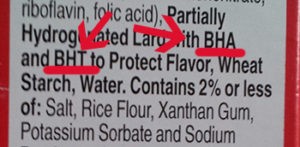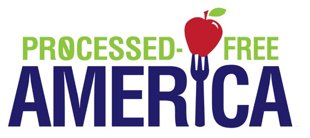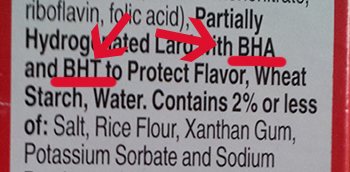
We’ve known for years that foods containing special nutrients called antioxidants can help prevent degenerative diseases and cancer, reduce blood pressure and slow the effects of aging. These naturally occurring compounds protect the body from harmful toxic compounds called free radicals, stopping them in their tracks and sweeping them up before they can cause damage. The best way to ensure your body has a storehouse of antioxidants that will make it inhospitable to toxic free radicals is by eating a wide variety of whole foods.
Unfortunately, the processed-food industry has taken advantage of the good reputation the term “antioxidant” has earned in recent years. They’re adding antioxidant food additives – namely man made chemicals such as BHT, BHA and TBHQ – to keep the oils in processed foods from going rancid and to prolong shelf life by protecting against deterioration and color changes.
It would be one thing to add chemicals into foods for the sole purpose of prolonging shelf life – but now processed food manufacturers are making “antioxidant” claims on their packaging, targeting and fooling unsuspecting consumers into thinking these foods actually contain “healthy” antioxidants. This is a prime example of how food manufacturers twist the definition of chemistry terms and present them to the public as sheep in wolve’s clothing.

Fake Man-Made Antioxidants
BHA stands for Butylated hydroxyanisole and BHT stands for the related compound butylated hydroxytoluene. Both are synthetic (man
-made) compounds that are often added to foods to preserve fats. They are called “antioxidants” because they are compounds that retard the chemical reaction that occurs when fats, oils, and oil-containing foods are exposed to air. That chemical reaction is called oxidation.
BHA and BHT are used in bacon, baked goods, breakfast bars, candy, canned fruits and vegetables, cream and creamers, fried foods, gelatin desserts, margarine, roasted nuts, peanut butter, powdered soups, salad dressings, shortening, spices, whipped topping, chewing gum, potato chips, the ubiquitous ingredient “vegetable oil, and foods containing artificial color or flavor. These fake antioxidant chemicals prevent the color, flavor, or texture changes that occur when foods are exposed to air. You may also find it disturbing (I know I did) that these same chemicals are also used for the same purposes in cosmetics, pharmaceutical drugs, rubber & petroleum products, jet fuels, and embalming fluids.
TBHQ stands for Tert-butylhydroquinone. It’s a white, crystalline solid used as a general-purpose chemical to preserve various oils, fats and food items by retarding their oxidative deterioration. It is also used in formulating varnish, lacquer, resins and oil field additives, AND is used as a fixative in perfumes to reduce the evaporation rate and improve stability.
Wow, with so many uses, one must wonder how safe any of these substances are for human consumption!
What these food additives DO NOT do is act like the antioxidants that come from real whole plant foods. In fact, they do the exact opposite. The International Agency for Research on Cancer considers BHA and BHT carcinogenic (cancer causing). Repeated studies agree that BHA and BHT increase the risk of cancer, accumulate in body tissue, cause liver enlargement, and retard cell development. These chemical food additives may also cause hives and other skin reactions. TBHQ has not been adequately tested, yet has still been approved for food use.
Some experts believe that consumption of BHT can cause metabolism problems leading to behavior changes. Dr. Benjamin Feingold, a diet specialist in the 1970’s stated from his studies that BHT could produce hyperactivity in children. In light of this, isn’t it interesting that many of the foods that are mainly consumed by children, including breakfast cereals, convenient lunch box meals, and snack foods all contain BHA and BHT?
Author and doctor Christine Hoza Farlow states in her book Food Additives – A Shopper’s Guide to What’s Safe & What’s Not – that BHA and BHT can cause liver and kidney damage, behavioral problems, infertility, weakened immune system, birth defects, and cancer. Infants, young children, pregnant women and those sensitive to aspirin should avoid them. My opinion is that everyone should avoid them.
BHT has been banned in England. It has also been banned in Romania, Sweden, Australia and nearly every other country except for the U.S. This makes one wonder why, if a substance is questionable enough to be banned in other countries, is it still used in most major cereal companies in America and why it also shows up in many other processed foods, especially those that are marketed to children?
The Real Antioxidants – Compounds in Whole Plant Foods
As the name implies, antioxidants are compounds that are the opposite of “oxidants”. Otherwise known as “free radicals”, oxidants are harmful molecules that can damage our body’s cells, proteins, and DNA. This damaging process, called “oxidation”, is largely responsible for speeding up the aging process and for the development of chronic diseases such as cancer, heart disease, stroke, Alzheimer’s disease, Rheumatoid arthritis, and cataracts. A similar type of oxidative process is what causes oils to become rancid, peeled apples and avocadoes to turn brown, and iron to rust.
Free radicals arise from sources both inside and outside our bodies. Free radicals that develop from processes within our bodies form as a natural result of normal breathing, metabolism, and inflammation. Outside of our bodies, however, free radicals form from environmental factors such as pollution, sunlight, strenuous exercise, X-rays, smoking and alcohol. One of the most prevalent sources of outside free radicals is from eating foods that have been cooked in oils that have been heated too high (fried foods and baked goods) or from foods that have processed oils added to them, such as salad dressings, ice creams, puddings, creamers, etc.
Free radicals are molecules that have lost one of their electrons due to their exposure to heat, light, or air. Their electron deficiency renders them highly reactive and unstable. Free radicals want nothing more than to recoup their lost electron in order to become stable again, so they scavenge our bodies to steal electrons from healthy cells, thereby creating more free radicals. As a result, free radicals multiply to a point called oxidative stress, a point beyond the body’s ability to neutralize them. When this occurs, premature aging and disease takes over.
Your only defense against free radicals are antioxidants. Antioxidants from plant foods are what you need because they are the only compounds capable of preventing or stopping the damaging effects of oxidation in your body. An antioxidant has an extra electron, and its sole purpose is to donate its extra electron to the free radical in order to stop it from doing further damage.
The man-made fake antioxidants cannot do this for you, because their extra electron has already been used to retard the rancidity of the oil in the processed foods. And, as I have already mentioned, they have harmful effects on human health as a result. There is nothing healthy about these types of “antioxidants”. It is a complete misrepresentation of the compounds and their role in nature.
True Food Sources of Antioxidants
In nature, plant foods are loaded with compounds called phytochemicals. Phytochemicals are the biologically active substances in plants that are responsible for giving them color and flavor, and they protect our cells against oxidative damage and reduce the risk of developing certain types of cancer. Most phytochemicals are also antioxidants, as well as vitamins A, C, and E, and the mineral Selenium. The following is a list of some of nature’s most powerful antioxidant foods:
- Beans contain some of the highest amounts of antioxidant compounds of any other plant foods. In fact, small red kidney beans rate the highest, just ahead of blueberries. In general, darker colored beans are associated with higher levels of flavonoids, and therefore higher antioxidant activity. A 100-gram serving of black beans contains 10 times the amount of antioxidants in an equivalent serving of oranges, and similar to the amount found in an equivalent serving size of grapes, apples, and cranberries.
- Blueberries, raspberries and blackberries are rich in proanthocyanidins, antioxidants that can help prevent cancer and heart disease. Strawberries, raspberries and blackberries contain ellagic acid, a plant compound that combats carcinogens
- Broccoli and other cruciferous vegetables like cabbage, cauliflower and Brussels sprouts, can help prevent cancer and ward off heart disease. Cruciferous vegetables contain a compound called indole-3-carbinol (I3C – a potent antioxidant that breaks down estrogen in the body) that reduces the risk of breast cancer and other estrogen-sensitive cancers, like cancer of the ovaries and cervix. Other studies have shown that broccoli can help fight cervical dysplasia, a precancerous condition. Broccoli also contains other protective constituents like beta-carotene, which can help prevent cancer and heart disease.
- Carrots are loaded with a potent antioxidant called beta-carotene, a member of the healing family of carotenoids. Also found in beets, sweet potatoes and other yellow-orange vegetables, beta-carotene provides protection against: cancer, especially lung, bladder, breast, esophageal and stomach cancers; heart disease, and the progression of arthritis by as much as 70 percent.
- Tomatoes can ward off certain kinds of cancer, prevent macular degeneration and cataracts, and help maintain mental function as we age. Tomatoes contain lycopene, a relatively rare member of the carotenoid family of antioxidants, also found in pink grapefruit and twice as powerful as the beta-carotene found in yellow and orange fruits and vegetables. Studies have shown that men who eat more tomatoes or tomato sauce have significantly lower rates of prostate cancer. Other studies suggest lycopene can help prevent lung, colon and breast cancers. Tomatoes also contain the antioxidant glutathione, which helps boost immune function. Note: cooked tomatoes are preferable, since heat allows more desirable antioxidants in tomatoes to be made available to the body. And because lycopene is fat-soluble, eating tomatoes with healthy oils can improve absorption.
- The skins of red grapes contain substances called resveratrol and quercetin. These potent antioxidants boost heart health by acting as free-radical scavengers, reducing platelet aggregation and helping blood vessels remain open and flexible. Resveratrol can also protect against cancer and reduce the risk of inflammatory diseases, gastric ulcers, stroke and even osteoporosis.
- Garlic is packed with antioxidants that can help fend off cancer, heart disease and the effects of aging. The sulfur compounds that give garlic its pungent odor are thought to be responsible for its healing benefits. Studies have shown that garlic keeps the heart healthy by lowering cholesterol levels, reducing blood pressure, fighting free radicals and keeping blood from clotting. Other studies suggest that eating garlic regularly can help prevent cancer.
- Spinach contains an antioxidant called lutein which helps protect your vision. Studies have shown that people who eat spinach are less likely to develop cataracts and macular degeneration, the two most common causes of vision loss. Lutein appears to work by shielding the retina from sun damage and fighting free radicals that can harm the eyes. Some preliminary studies have suggested that lutein can also help prevent heart disease.
- Both green tea and black tea are rich in polyphenols, which are a type of antioxidant. These wonder nutrients scavenge for cell-damaging free radicals in the body and detoxify them. They have been shown to significantly reduce the risk of cancer, heart disease, stroke and other diseases. Whether it’s green or black, tea has about eight to 10 times the polyphenols found in fruits and vegetables. Black and green tea both have flavonoids called thearubigins, epicatechins, and catechins, which are different types of antioxidants than what are found fruits and vegetables. Both types of tea block DNA damage associated with tobacco and other toxic chemicals. In animal studies, tea-drinking rats have less cancer. Herbal teas may also contain antioxidants but less is known about them.
- Vitamin E in whole grains like brown rice, oats, buckwheat and whole wheat is a potent antioxidant that plays a role in preventing cancer, especially prostate cancer. Other studies have found that it can boost immunity, slow the progression of Alzheimer’s disease, treat and possibly prevent arthritis, prevent sunburn and treat male infertility. Whole grains are also rich in phytic acid, known as IP-6, a potent antioxidant that can help protect against breast, colon and liver cancers.
Eating a wide variety of vegetables (4 cups per day) and fruit (three servings per day) can ensure you get a decent amount of antioxidants. But the bottom line comes down to this: eat foods in their most closest to natural form as possible. There are plenty of natural alternatives to BHA and BHT laced foods. Many natural and organic companies produce delicious products without these toxic preservatives.
Become an avid ingredient list reader, because the ingredient list is what tells you whether a food is healthy or not. When you avoid processed foods, you avoid all the dangers associated with food additives, and you avoid being fooled by clever marketing claims.

